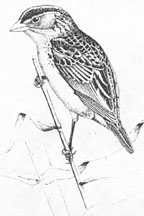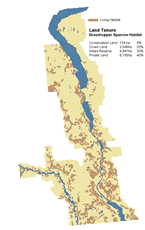|
Habitat Atlas for Wildlife at Risk
Grasshopper Sparrow
Ammodramus savannarum

Grasshopper
Sparrow
|

- Length: 12 cm.
- Unstreaked breast is buff colour.
- Yellow spot at bend of wing and between eye and
base of bill.
- Tail is very short and narrow.
Status:
British Columbia Red List
Special Significance
This secretive bird occurs in British Columbia in very
low numbers in dry grassland habitats that are being
lost to agriculture and urban development. The remaining
bunchgrass rangelands must be properly managed and
maintained to provide the habitat these birds require.
Improving the condition of rangeland to provide tall,
healthy bunchgrasses and low shrub density should
be a priority for habitat preservation.
Distribution
- In British Columbia, this bird breeds in the Okanagan and Lower
Similkameen valleys.
- Nine known breeding sites in British Columbia; only
2 of which are regularly used-Goose Lake near Vernon
and the West Bench grasslands on the Penticton Indian Reserve.
- Elevational range is 275 to 945 metres.
Habitat
- Birds prefer native shrub-grasslands composed of short to middle
height (20 to 60 cm) grass cover with 25 percent
cover as bare ground.
- Breeding occurs in areas with lower grass cover, less
litter and greater forb height and variability
in dispersion than areas occupied during non-breeding season.
- Sparrows forage in open unvegetated areas.
Reproduction
- Sparrows arrive at breeding sites in May.
- Birds nest on the ground, in clumps of dense grass.
- Lay 3-6 eggs in early June; normally 2 broods per summer.
Food Habits
- Diet consists of seeds, forbs and insects.
Interesting Facts
- High-pitched song sounds like the long buzz of an insect; often sings
at night.
Threats
- Habitat loss due to agriculture and urban development
in low elevation shrub/grasslands.
- Moderate to heavy grazing in most remaining shrub-grassland
areas which decreases grass cover and height
and increases shrub density.
- Use of insecticides and herbicides could be
directly harmful or reduce prey and habitat.
- Seeding ranges with non-native grasses.
Management Considerations
- Avoid development or cultivation of remaining
low elevation dry shrub-grasslands.
- Employ land management practices which encourage
the growth of healthy indigenous grassland
communities.
- Seed rangelands with native grasses whenever
possible.
- Carefully monitor and reduce use of pesticides.
|
References
1. Cannings, R.J. 1995. Status of the Grasshopper Sparrow in British
Columbia. Wildlife Branch. Ministry of Water, Land and Air Protection
Lands and Parks, Victoria, British Columbia
2. Cannings, R.A., R.J. Cannings and S.G. Cannings.
1987. Birds of the Okanagan Valley, British Columbia. Royal British
Columbia Museum, Victoria, B.C.
|